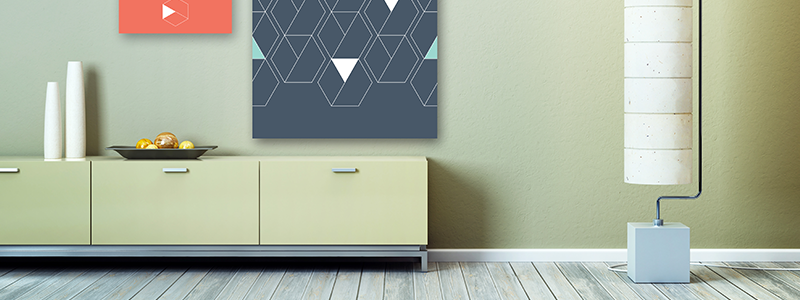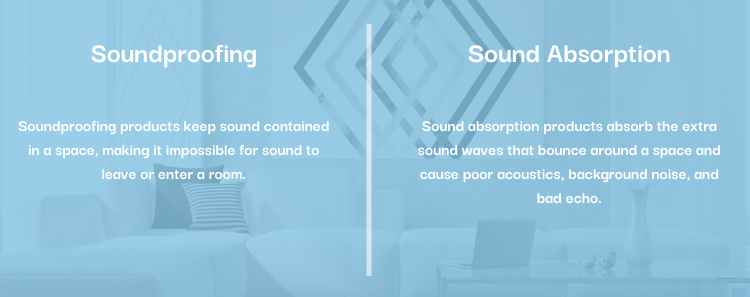-
What is STC? To be able to compare the performance of different soundproofing products, we rate them by how much sound they can block.
- To be able to compare the performance of different soundproofing products, we rate them by how much sound they can block. This rating is called STC, which stands for Sound Transmission Class. Click here to learn more about STC. Generally, the higher the STC rating, the better the material is at blocking sound.
-
What is NRC? To be able to compare the performance of different sound absorption products, we rate them by how much sound they can soak up.
- To be able to compare the performance of different sound absorption products, we rate them by how much sound they can soak up. This rating is called NRC, which stands for Noise Reduction Coefficient. Click here to learn more about NRC. Generally, the higher the NRC rating, the better the product is at absorbing sounds.
-
2 Types of Soundproofing Products: Sound Blockers and Sound Absorbers
- There are 2 types of soundproofing products: sound blockers and sound absorbers. The origin of your sound issue will determine the best product type for you.
-
Sound Blockers - Use sound blockers to stop sound from traveling from one space to another.
- If the sound you need to control is not originating from the same space as you, sound blockers are the best solution. Sound blockers stop, reflect, or reroute noise to prevent its transmission through a surface. They are hard, heavy, and flexible. Use sound blockers to stop sound from traveling from one space to another. Sound blockers can be installed in walls, doors, floors, and ceilings.
-
Sound Absorbers - Absorption products control noise within an enclosed area, improving the sound quality.
- If the noise you need to control is originating in the same space as you, sound absorbers are the best solution. Sound absorbers soak up, trap, and dissipate noise energy. They are light, porous, and soft to the touch. Absorption products control noise within an enclosed area, improving the sound quality. Because they usually are a finishing product, they are available in many different styles and colors to match any decor.


Soundproofing vs Sound Absorption
Sound is a lot like water. It doesn’t have a shape or form and always takes the path of least resistance. Like water, sound can be absorbed by some materials and contained by others. This is why both soundproofing materials and sound-absorbing materials co-exist and serve separate purposes.
(Click here to learn more sound basics.)
What’s the Difference Between Soundproofing and Sound Absorption?
Soundproofing refers to materials that contain sound within the confines of a space. Sound absorption products absorb sound waves that bounce around a room and create background noise, echo, and poor acoustics.
Soundproofing products are what you want if you’re looking to keep what happens in your conference rooms confidential. On the other hand, sound absorption products don’t stop sound from traveling into adjoining rooms, but they do drastically improve speech intelligibility and the sound quality within rooms and other enclosed spaces.
In an attempt to rid yourself of unwanted noises quickly, you could erroneously mix up these terms and invest in the wrong material for your home or business. While you will often find sound-blocking and sound-absorbing materials used in conjunction to provide a barrier against noise pollution and sound, they each offer unique benefits and resolutions that make them suited for separate purposes. We have outlined everything you need to know about sound absorbing vs. soundproofing below.
Sound Absorption
Absorption refers to the process by which sound-absorbing material takes in the energy of a sound wave, rather than reflecting the energy. This effectively reduces the level of echo and sound waves that travel within your space. So if you want to be able to hear more clearly within your space, sound absorption materials are your go-to solution.
Sound absorption products are not ideal for an individual who wants to block noise from entering or leaving their home. Sound absorption products do not stop sound from traveling. They absorb frequencies to improve the acoustical properties heard from within the room.
Foam and sponges soften the surfaces in a space, making them excellent sound absorption materials. In effect, this dampens the production of airborne sounds.
Shop Sound Absorption Materials
How Sound Absorption Works
Sound absorption treatments, which are generally made of soft materials like fabric or foam, work by trapping sound waves. Porous materials have microscopic openings that absorb the sound waves the same way a sponge absorbs water.
The trapped energy of the sound waves converts into heat as the absorbent foam makes it impossible for the waves to bounce onto another surface. As a result, the environment becomes more quiet and reverberations and echoes are reduced. The sound absorption materials actually change the acoustic energy of the sound into heat, causing the molecules to vibrate. As long as the sound in the room is powerful enough, the molecules will move and become caught in the sound absorption product.
Common Applications of Sound Absorption
A variety of sound absorption products have been used in the following industries and buildings that require noise reduction effects:
- Restaurants: A dining experience can quickly become chaotic due to the excess noise of various conversations and clattering plates. Proper sound absorption materials prevent these sounds from bouncing around the room and improve the dining experience for customers.
- Open offices: Collaborative work environments with open layouts can often be loud and produce echoes. Sound absorbers can reduce the noise of phone calls and meetings, allowing for better concentration.
- Concert halls: Sound absorption materials are typically used where higher acoustic quality is needed, such as in concert halls, theaters and broadcasting studios. Sound absorption products help balance sound and enhance clarity in these spaces.
Soundproofing
Soundproofing materials minimize the level of sound that enters a room by reducing the frequency waves before they reach your ears. These products and materials are ideal for reducing unwanted sounds from entering a room in a residential or commercial space.
Materials crafted to block sound transmission are often heavy and sturdy, unlike their porous and lightweight sound absorption counterparts. Mass Loaded Vinyl, for instance, creates a robust sound barrier between the internal and external noise in a room. In effect, this form of soundproofing produces an environment in which noise generated within the studio stays inside while sound from your external surroundings stays out.
How Soundproofing Works
Unlike sound absorption, soundproofing works by using heavy, dense materials that create a thick barrier between two spaces. Picture a thin sheet of drywall versus a brick wall. The brick wall has a much heavier mass, making it much more difficult for sound to travel through. Sealing gaps in a room or building using door sweeps, weatherstripping and sealants also prevents sounds from escaping.
Soundproofing can be achieved by blocking noise by adding mass, stopping sound vibrations from traveling or reducing the amount of sound that travels through a structure.
Common Applications of Soundproofing
Soundproofing can be used in a wide variety of applications to control sounds in a space, including:
- Music studios: Recording music can be extremely loud. Soundproofing prevents music production noises from being heard outside the studio and reduces the risk of external noise leaking into studio recordings.
- Home theaters: Watching movies and TV shows in a home theater is the ultimate entertainment experience. Just like in a real movie theater, home theaters can benefit from soundproofing treatments that contain the sound on the big screen and prevent outside noises from disrupting the movie.
- Hotels: Adding soundproofing materials in hotels allows guests to relax without hearing excessive noise from adjoining rooms or nearby construction.
What Sound Absorption and Sound Blocking Have in Common
Often, you will find that sound absorption and sound-blocking materials complement one another to enhance the acoustical properties of varying rooms. While their uses differ, the two different soundproofing products share one overarching purpose: to help you obtain the level of noise and reverberation reduction you desire.
Ideal Applications
Finding the right product for you depends upon the circumstances you seek to improve. Does your room suffer from echoing and unwanted reverberations from within? Then sound absorption foams are the product for you! Spaces such as music studios and gymnasiums would find their acoustical properties significantly enhanced after installing a sound absorption product.
If you have loud neighbors or find yourself distracted by noise pollution throughout the day, opt for a sound-blocking product instead. When your goal is to block noise by trapping it outside, you need a strong enough barrier to provide a wall that separates internal and external noise. Sound-blocking products offer just the protection you need to obtain noise control throughout the day.
Whether you need sound-absorbing or soundproofing materials, Soundproof Cow has you covered. To find out more about our products or for further assistance in choosing the perfect product for you, fill out our contact form today.

I just wanted to let you know that in the end, sealing the air spaces on this door worked just fine and took care of the problem.
I really appreciate you taking so much time to share your expertise with me, and in particular recommending I try the simpler solution before investing in more expensive noise barriers. That is a big credit to you and your business.
- Mike

